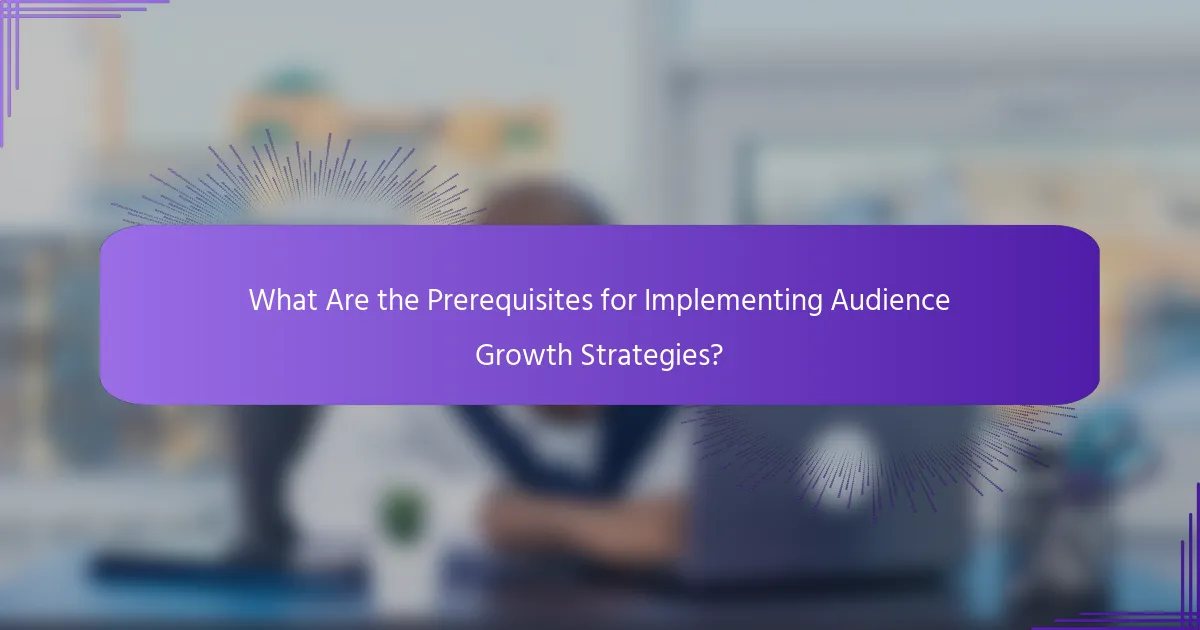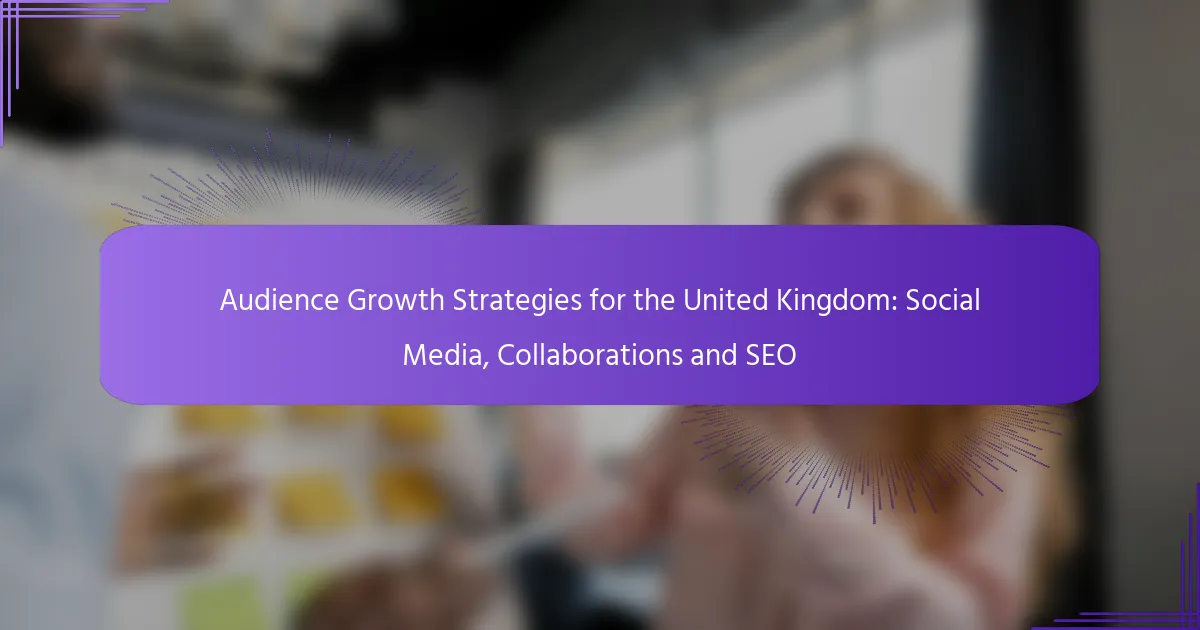To effectively grow your audience in the United Kingdom, it’s essential to implement a combination of social media strategies, collaborations, and SEO techniques. Engaging content on platforms like Instagram and TikTok can enhance visibility, while partnerships can expand your reach and credibility. Additionally, optimising your website for search engines will attract more visitors and improve overall engagement.

What Are Effective Social Media Strategies for Audience Growth in the United Kingdom?
Effective social media strategies for audience growth in the United Kingdom focus on engaging content, community interaction, and targeted advertising. By leveraging platforms like Instagram, TikTok, Facebook, Twitter, and LinkedIn, businesses can significantly expand their reach and connect with potential customers.
Utilising Instagram Reels
Instagram Reels are short, engaging videos that can capture attention quickly. Brands should create visually appealing content that showcases products or tells a story, ideally under 30 seconds, to maximise viewer retention. Using trending music and relevant hashtags can further enhance visibility.
To optimise engagement, consider posting Reels during peak hours, typically in the evenings or at weekends. Regularly analysing performance metrics helps refine future content strategies.
Engaging with TikTok Challenges
Participating in TikTok challenges can rapidly increase brand visibility. Brands should create or join trending challenges that align with their identity, encouraging user-generated content. This not only boosts engagement but also fosters community involvement.
To succeed, keep the challenge simple and fun, ensuring it resonates with your target audience. Collaborating with influencers can amplify reach and enhance credibility.
Leveraging Facebook Groups
Facebook Groups provide a platform for building community and fostering discussions around shared interests. Brands can create their own groups or engage in existing ones relevant to their niche, offering valuable insights and support.
Active participation is key; respond to comments and questions promptly. Regularly share exclusive content or host events to keep members engaged and encourage growth through word-of-mouth referrals.
Creating Shareable Content on Twitter
Shareable content on Twitter can significantly enhance audience reach. Focus on crafting concise, impactful tweets that include visuals or infographics to capture attention. Engaging with trending topics or using popular hashtags can also increase visibility.
Encourage retweets by asking questions or prompting discussions. Regularly monitoring analytics helps identify what resonates with your audience, allowing for adjustments in content strategy.
Running Targeted Ads on LinkedIn
LinkedIn ads can effectively target professionals and businesses, making them ideal for B2B growth. Utilise LinkedIn’s targeting options to reach specific industries, job titles, or company sizes, ensuring your message reaches the right audience.
Consider using sponsored content or InMail campaigns to engage users directly. Monitor ad performance closely and adjust your strategy based on engagement metrics to maximise return on investment.

How Can Collaborations Enhance Audience Growth?
Collaborations can significantly boost audience growth by leveraging the established networks of partners. By working together, brands can reach new audiences, increase credibility, and enhance content offerings.
Partnering with Influencers
Partnering with influencers allows brands to tap into their followers, who often trust their recommendations. Choose influencers whose audience aligns with your target demographic to maximise impact.
Consider micro-influencers, as they typically have higher engagement rates and are more cost-effective. Aim for partnerships that include authentic content creation, such as product reviews or social media takeovers.
Co-hosting Webinars with Industry Leaders
Co-hosting webinars with industry leaders can attract a wider audience by combining expertise and resources. This strategy positions both parties as thought leaders while providing valuable content to attendees.
Promote the webinar across both partners’ channels to maximise reach. Ensure the content is relevant and engaging, and consider offering incentives, like downloadable resources or exclusive discounts, to encourage participation.
Cross-promoting with Complementary Brands
Cross-promoting with complementary brands allows you to reach potential customers who are already interested in related products or services. Identify brands that share similar values and target audiences.
Strategies can include joint social media campaigns, shared email newsletters, or bundled offers. Ensure that the promotions are mutually beneficial and maintain a consistent brand message throughout.
Joining Affiliate Programs
Joining affiliate programmes can expand your audience by allowing partners to promote your products in exchange for a commission on sales. This performance-based model incentivises partners to effectively market your offerings.
Choose affiliate programmes that align with your brand and have a good reputation. Provide affiliates with the necessary tools, such as banners and product information, to help them succeed in promoting your brand.

What SEO Techniques Are Essential for Audience Growth?
Effective SEO techniques are crucial for audience growth, as they enhance visibility and attract more visitors to your website. Key strategies include optimising for local search, utilising long-tail keywords, improving page load speed, and creating quality backlinks.
Optimising for Local Search
Local search optimisation involves tailoring your online presence to attract customers in specific geographic areas. This includes claiming your Google My Business listing and ensuring your name, address, and phone number (NAP) are consistent across platforms.
Incorporate local keywords into your content and meta descriptions to improve search rankings. For example, if you run a bakery in London, use phrases like “best bakery in London” to target local customers effectively.
Utilising Long-Tail Keywords
Long-tail keywords are specific phrases that typically have lower search volume but higher conversion rates. These keywords often reflect user intent more accurately, making them valuable for attracting targeted traffic.
For instance, instead of targeting “shoes,” focus on “best running shoes for flat feet.” Tools like Google Keyword Planner can help identify effective long-tail keywords relevant to your niche.
Improving Page Load Speed
Page load speed is critical for user experience and SEO rankings. A slow-loading site can lead to higher bounce rates, negatively impacting your audience growth. Aim for a load time of under three seconds.
To enhance speed, optimise images, leverage browser caching, and minimise HTTP requests. Tools like Google PageSpeed Insights can provide actionable recommendations to improve your site’s performance.
Creating Quality Backlinks
Quality backlinks from reputable websites signal to search engines that your content is valuable. Focus on earning backlinks through guest blogging, partnerships, and creating shareable content that others want to link to.
Consider reaching out to local businesses or industry influencers for collaboration opportunities. Aiming for backlinks from sites with high domain authority can significantly boost your own site’s credibility and search rankings.

What Metrics Should Be Used to Measure Audience Growth?
To effectively measure audience growth, focus on metrics that reflect engagement, traffic, conversions, and reach. These metrics provide insights into how well your strategies are working and where adjustments may be needed.
Tracking Engagement Rates
Engagement rates indicate how actively your audience interacts with your content. This includes likes, shares, comments, and time spent on posts. Aim for engagement rates of 1-3% on social media platforms as a benchmark for healthy interaction.
To track engagement, use analytics tools provided by social media platforms or third-party services. Regularly review these metrics to identify which types of content resonate most with your audience and adjust your strategy accordingly.
Analysing Website Traffic
Website traffic metrics reveal how many visitors are coming to your site and how they navigate through it. Use tools like Google Analytics to monitor unique visitors, page views, and average session duration. A good target is to see a steady increase in unique visitors month over month.
Pay attention to traffic sources, such as organic search, social media, or referrals, to understand where your audience is coming from. This information can help you optimise your marketing efforts and focus on the most effective channels.
Monitoring Conversion Rates
Conversion rates measure the percentage of visitors who take a desired action, such as signing up for a newsletter or making a purchase. A typical conversion rate for e-commerce sites ranges from 1-3%. To improve this metric, ensure your calls to action are clear and compelling.
Regularly analyse your conversion funnel to identify drop-off points. A/B testing different elements, such as landing page design or content, can help you determine what drives higher conversions.
Evaluating Social Media Reach
Social media reach refers to the total number of unique users who see your content. This metric helps gauge the effectiveness of your posts in reaching a broader audience. Aim to increase your reach by 10-20% over a few months through targeted campaigns and collaborations.
Utilise social media insights to track reach across different platforms. Engaging with followers and sharing user-generated content can enhance your visibility and encourage organic growth. Regularly assess which platforms yield the highest reach and adjust your strategy accordingly.

What Are the Prerequisites for Implementing Audience Growth Strategies?
To effectively implement audience growth strategies, businesses must first understand their target audience and establish clear objectives. These prerequisites lay the foundation for successful engagement and expansion efforts across various platforms.
Defining Target Audience
Defining your target audience involves identifying the specific groups of people most likely to engage with your content or products. Consider demographics such as age, gender, location, interests, and online behaviour. For example, a brand targeting young adults may focus on platforms like Instagram and TikTok, while a business aimed at professionals might prioritise LinkedIn.
Utilise tools like surveys, social media analytics, and customer feedback to gather insights about your audience. This data helps in creating tailored content that resonates with their preferences, ultimately driving engagement and growth.
Setting Clear Goals
Setting clear goals is crucial for measuring the success of your audience growth strategies. Goals should be specific, measurable, achievable, relevant, and time-bound (SMART). For instance, a goal could be to increase social media followers by 20% within six months or to boost website traffic by 30% over the next quarter.
Regularly review and adjust your goals based on performance metrics. This adaptability ensures that your strategies remain aligned with audience needs and market trends, maximising your growth potential.
